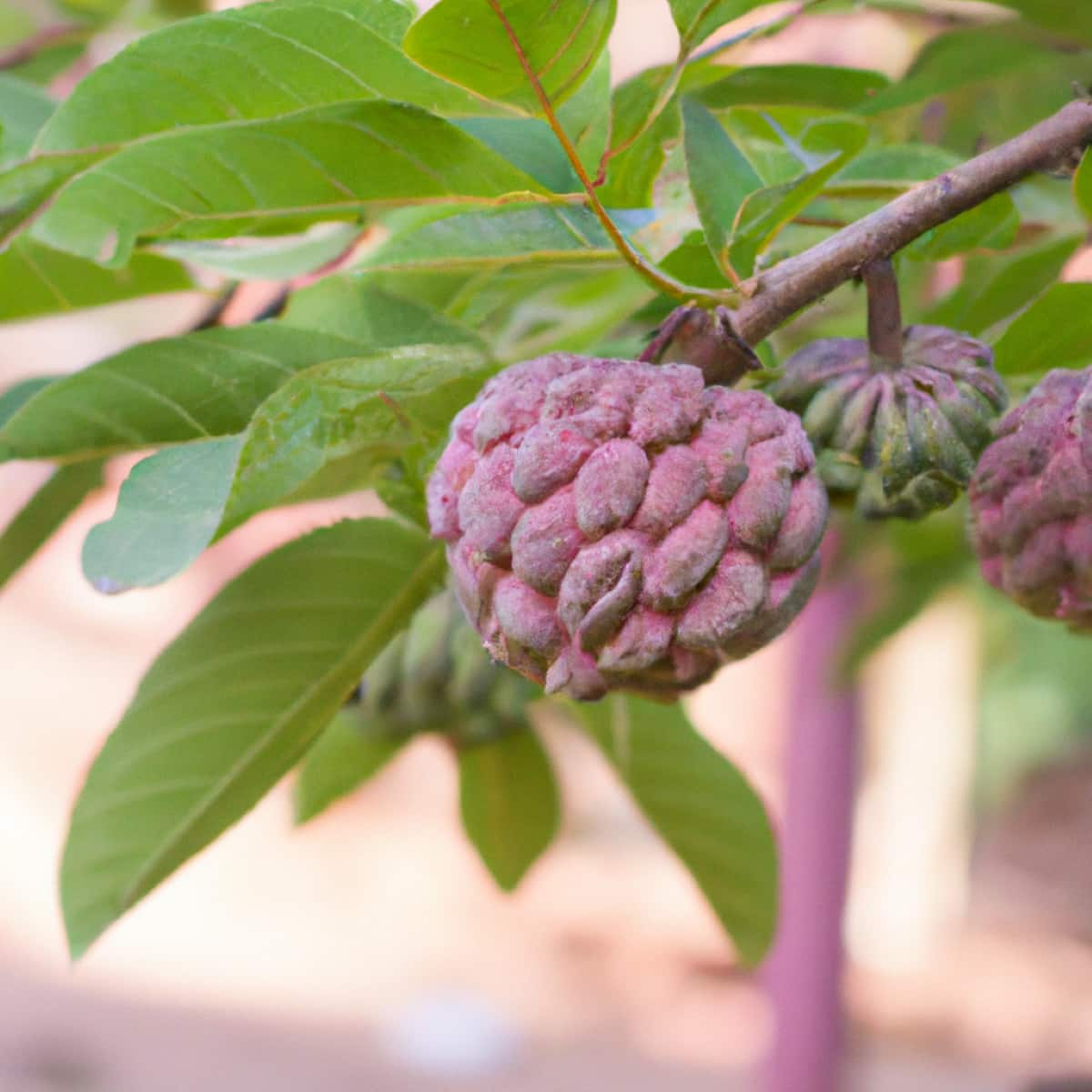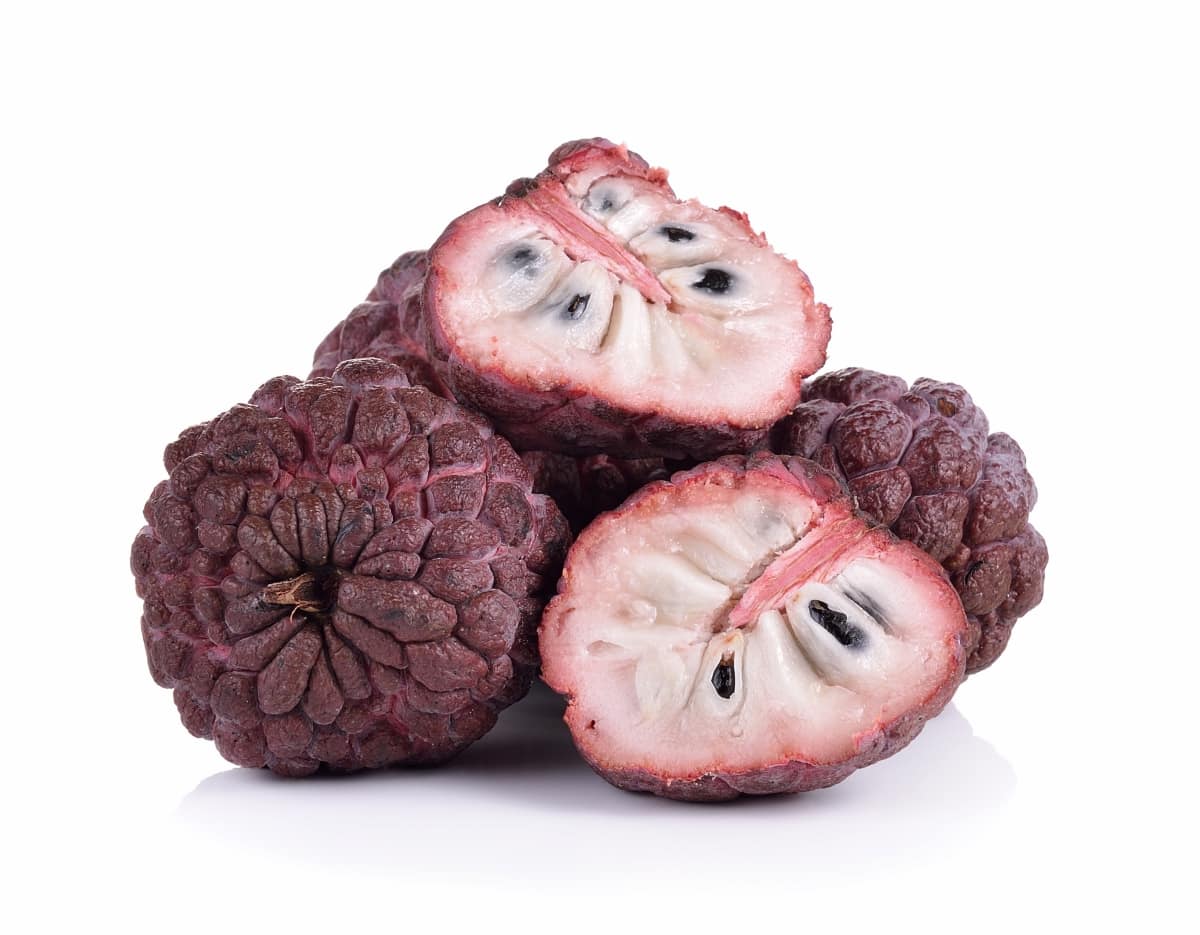It is believed that Purple Custard Apple originated in West Indies and Central America, where ancient Indian sculptures depict the fruit. There are Purple Custard Apples worldwide, but they are also found along the southeast and southwest coasts of Florida, where it is the warmest. Indian horticulturists have studied this Custard Apple extensively, and they have identified ten different varieties ranging in color, size, shape, and flavor. As well as its superior taste, the Purple variety is prized for its decorative landscaping qualities.

How to Grow Purple Custard Apple from Seed
Purple Custard Apple Characteristics
- A knobby, velvety rind gives it a scale-like appearance with its thick, velvety rind.
- Its exterior is dark blueish-purple with magenta accents along its scaly edges.
- In the center, the flesh is juicy and succulent, with a creamy white color and pale purple tinges.
- It is composed of fleshy conical segments that contain large black seeds that are inedible.
- The Purple Sugar Apple is soft enough to be split open with your fingers when fully ripe, giving off a sweet, sugary aroma.
- The flavor is reminiscent of tropical fruits such as mango and pineapple, with berry tones and a vanilla custard finish.
Soil Requirements for Growing Purple Custard Apple
Purple Custard Apple fruit can adapt to a variety of soil conditions. Soils such as sand, clay, and loam are suitable for growing it. A fertile, loose, deep soil is recommended for a heavy, delicious yield. A well-draining soil is also better than sandy soil. Diseases can be prevented by maintaining good drainage. Soil organic matter will play a major role in the growth of Purple Custard apples. For optimum growth, you should use soil rich in organic matter.
Sunlight Requirements for Growing Purple Custard Apple
Ideally, Purple Custard apples should be grown in full sun conditions. You should avoid keeping the plant in the shade because doing so will result in the plant not producing any fruit. The chosen location should receive 4-6 hours of sunlight a day.
Ideal Climate and Temperature Requirements for Growing Purple Custard Apple
Ideally, Purple Custard Apple trees should be grown at a temperature of 10-30°C. Seedlings and young plants die when temperatures fall below 0°C, however. In mature trees, frost tolerance can extend to some degrees below freezing. Pollination is affected by temperature, fruit or bud drop occurs, and post-harvest life is diminished when temperatures exceed or fall below optimum temperatures. Especially when the plant starts to flower, maintain humidity above 60% to maximize production. Pollination and flowering are both influenced by humidity.
Planting Purple Custard Apple From Seed
While growing Purple Custard apples from seedlings takes some time and requires transplanting, it is better than growing Purple Custard apples from seeds. Seeds should be soaked in water, wrapped in paper towels, and placed in ziplock bags for three days before planting them. The seeds can be scarified using sandpaper and soaked in water for a day if you prefer. A sunny location and good soil are needed for the seeds to germinate. Warmth and light are essential for purple custard apple seeds.
In case you missed it: How to Grow Rose Apple / Wax Apple / Water Apple / Java Apple from Seed: Planting and Care

Your seeds may need to grow lights if you cannot provide enough sunlight. You should use a container at least three inches deep for seedlings. Drainage holes must be present. Make sure it is moist and damp by filling it with soil. Plant the seeds in the soil 3 cm deep. Seeds should be watered carefully. Custard apple seeds prefer moist soil but not waterlogged soil. After the seedlings have matured, you can transplant them outside in the garden or into a bigger pot.
Watering Requirements for Growing Purple Custard Apple
It can withstand extended periods of drought. Excessive drought, however, can result in leaf and fruit drop. For optimal growth, it requires rainfall between 750 and 1,200 mm per year. It is necessary to stop watering when it is raining. It is generally recommended that mature trees be watered every 12 to 15 days. More details are provided below. These don’t like soggy soil, as we already saw. Therefore, give them the appropriate amount of water.
- You should only water your soil when you see it is dry above 2-3 inches
- Summers and dry climates require frequent watering
- When flowering and fruiting, it requires a little more water.
- Arid and hot climates do not pose a problem for these plants.
Fertilizer Requirements for Growing Purple Custard Apple
You should fertilize the plants during their first few years with a complete fertilizer. The tree will need a complete fertilizer to get started. Root development can be improved by using organic fertilizer. Fertilizers such as 3-10-10 may improve yield in later years.
- During the growing season, you should fertilize a young tree every six to eight weeks.
- Fertilizer should be applied five to six times in the first year of growth.
- During the second and third years, fertilizer should be applied three to six times.
- Fertilizer applications should be reduced after the third year of growth.
Pruning Purple Custard Apple Trees
Trees of this type can grow to be tall. If left unpruned, they can reach 10-20 feet in height. It is also possible to prune them so that more lateral branches grow and vertical growth is reduced.
- The new growth can be pinched off when it emerges
- After they reach a certain thickness, you can prune them
Harvesting Purple Custard Apple
After planting the custard apple, you will be able to harvest its fruit after 3 to 4 years. Fruits will continue to be produced for 10 to 11 years. It will decline when it is 15 years old. It can be difficult to harvest this plant because the fruits aren’t all ripe at once. Choose mature and ripe fruits rather than harvesting them at random.
In case you missed it: How to Grow Apples Organically: A Step-By-Step Guide for Beginners

By looking at their size and color, you could identify them visually. Another indicator of fruit maturity is the color of the seeds. Harvesting custard apple plants requires special care because they are extremely delicate. Fruits can be harvested by cutting the stem with a sharp knife.
Conclusion
Purple Custard Apple trees thrive in the tropics as evergreen perennials. Colder climates will cause it to become deciduous. It can also be grown in subtropics. It is best to grow on sandy and loamy, well-drained soil. Many varieties of purple custard apples are grown commercially for their edible fruits and are used in local traditional medicine. This genus usually consists of evergreen or semideciduous plants that cannot tolerate frost.
- Feed Your Flock for Less: Top 10 Tips to Save on Chicken Feed
- Ultimate Guide to Ossabaw Island Hog: Breeding, Raising, Diet, and Care
- Hatching Answers: The Top 10 Reasons Your Chickens Aren’t Laying Eggs
- Eggs and Economics: Breaking Down the Cost of Raising Backyard Chickens
- Defend Your Greens: Proven Methods to Keep Iguanas Out of Your Garden
- Ultimate Guide to Cinnamon Queen Chicken: A Comprehensive Guide for Beginners
- Ultimate Guide to California Tan Chicken: Breeding, Raising, Diet, Egg-Production and Care
- Ultimate Guide to Marsh Daisy Chicken: Breeding, Raising, Diet, and Care
- 10 Types of Chicken Farming Businesses You Can Start for Profits